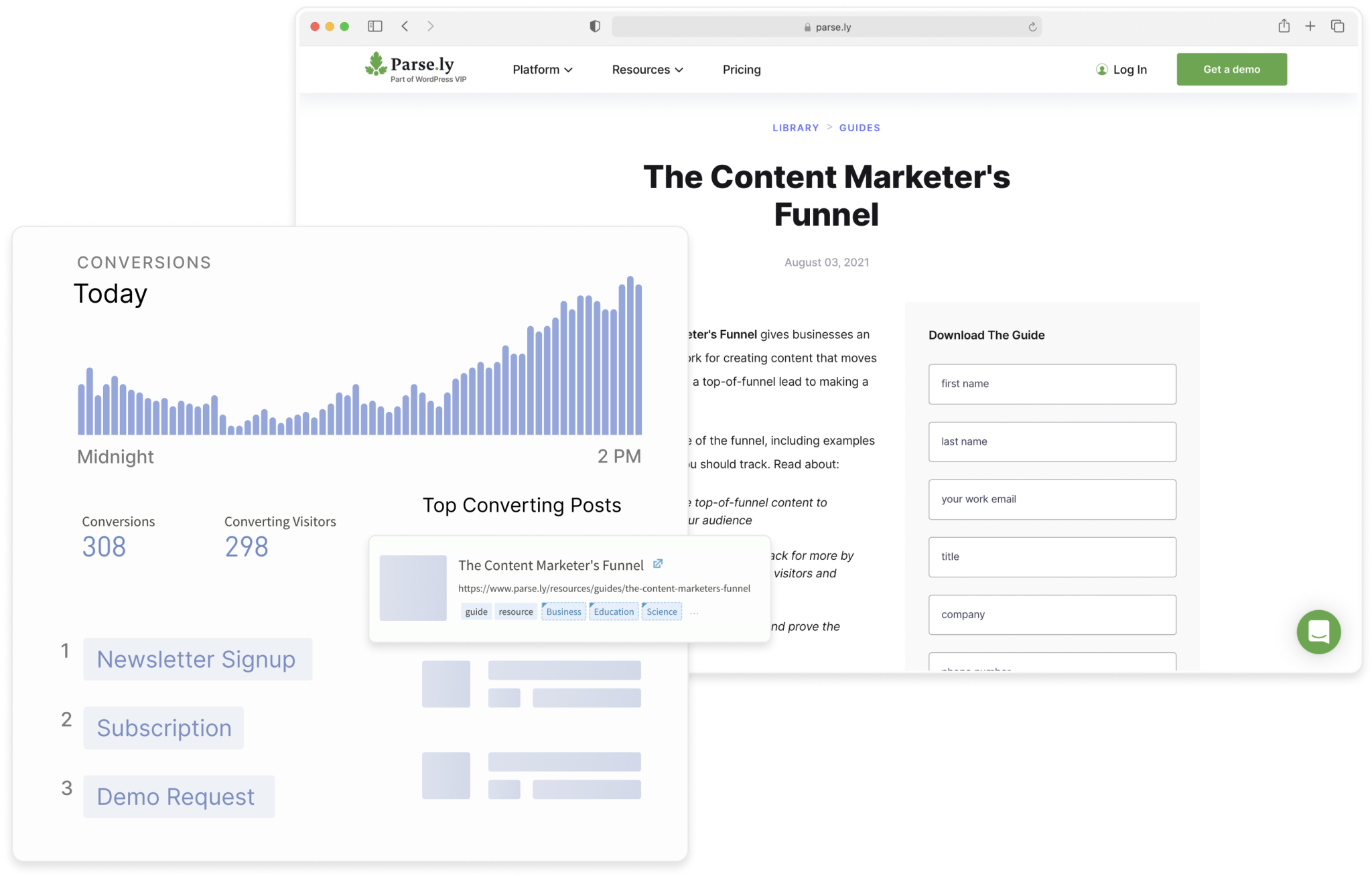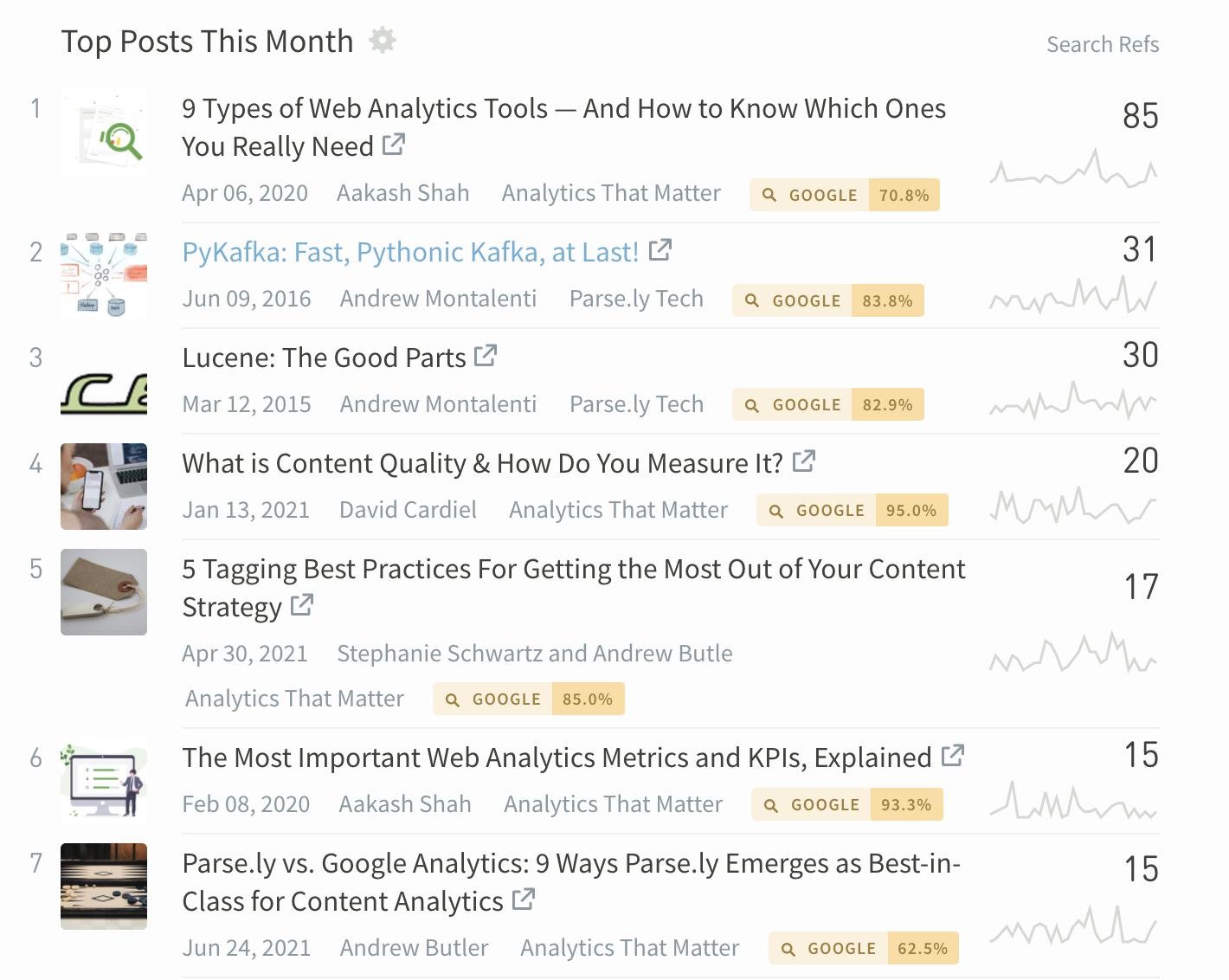5 Content Marketing Metrics That Matter in 2022

Content marketing—using blogs, video, podcasts, and other content to attract and convert an audience—has been around for ages, but people are still unsure of how to properly measure its effectiveness. In fact, almost half of the content marketers we surveyed in our Content Matters 2022 Report don’t feel like they really understand how their content is performing. They collect metrics but don’t know the impact of those metrics on their business or brand.
There are many content metrics, but some don’t give you a realistic picture of the impact your content is making. It’s especially important to focus on metrics that matter in 2022—like traffic, engagement, and conversions that measure the true value of your content.
When budgeting for content marketing in 2022, these are the metrics you need to watch to make sure it’s money well spent. We’ll show you how Parse.ly can help.
Table of Contents
1. Traffic
Traffic is the number of people who visit your webpage. This metric is important because the more people that view your site, the more potential customers you can gain. Every single page view is an opportunity to make an impression, find new leads, increase your brand’s reputation, and build a relationship with a customer.
Parse.ly identifies and tracks your site’s overall traffic in terms of page views, as well as a unique visitor count, which can be divided into “new” and “returning,” depending on the frequency of visits.
In 2022, with the pandemic still raging, and daily internet users up to 222 million people last year alone, traffic to your site should be increasing. If it’s not, you may be doing something wrong.
2. Conversions
Conversions measure how your content influences your readers to respond to the down-funnel calls-to-action on your site. They give a direct view into the ROI of your content. A conversion can be something as simple as a customer downloading an ebook or report, starting a free trial, calling your sales department, or signing up for a waiting list.
With Parse.ly Content Conversions, you get the full picture of how your content influences conversions. Define conversions as subscription sign-ups, newsletter sign-ups, lead generation form-fills, link clicks or any other event that matters to your business’s bottom line, and track how well your content influences those events.

The final conversion event itself, however, is only part of the whole content ROI picture. Prospects take baby steps toward an eventual purchase or a download each time they visit your blog or read any other content on your site.
Leverage Parse.ly’s linear content conversions model, which gives credit to every page viewed within 30 days of a conversion, to cite those baby steps and map how individual pieces of content lead to revenue-related conversion events over time.
3. Engaged time
Engagement, which shows how customers interact with your content, has traditionally been measured by page views, bounce rate, and time-on-page. Page views tell you when a reader clicks on a page. Bounce rate tells you when a person leaves a page. Time-on-page tells you how much time a reader spends with a page open.
The problem with all three of these metrics? They prioritize clicks over quality.
Parse.ly has a more meaningful way to measure engagement—engaged time. It more accurately depicts the true value of your content. Engaged time is more than just when a user opens a page and when they leave. It measures only the time when users are actively engaged with content (cursor movement, scrolling, video playing, etc.).
Engaged time helps you save time and effort by identifying content that may be getting a lot of clicks, but is not being read. If you’re writing 3,000-word articles but people only engage with them for 30 seconds, your time is likely better spent creating shorter content that packs more of a punch.
4. Keyword ranking
Keyword ranking measures how your content ranks or places for a certain keyword or phrase when found through organic search. When a user types that phrase into a search engine, you want your content to appear high up in the results.
SEO and high keyword ranking help bring more traffic to your web pages. If you gain a top spot on SERPs (search engine results pages), more people will look at your content.
One way to understand how well your keyword targeting is working is to look at which pieces of content bring in the most traffic to your site from search engines. Use Parse.ly’s search referral metric to see which pieces drive the most visits from search and ensure that your SEO efforts are paying off.

You might find older content that continually drives search traffic to your site. Make sure it’s current with updated links and information, and consider promoting it on other channels to maximize its impact.
5. Backlinks
Backlinks—links that point to your content from another website—are bolsters to your content’s (and your company’s) authority in your particular field.
Authority ensures that users will seek out and trust your thought leadership, and means that your content is well-researched, well-informed, and useful. Building that authority is what keeps people coming back to your company for advice and knowledge, fostering a base of loyal users. High authority rankings also improve your SEO and the results of your marketing campaigns.
Parse.ly can help here too. Use the referrer breakdown to see if certain sites drive significant traffic to your content. Consider finding ways to get future content in front of them to recreate that success.
Measure content marketing metrics that matter with Parse.ly
Eighty percent of content marketers we surveyed expect to create more content in the coming year. They’ll also be spending a lot more promoting that content. That makes the competition fierce in 2022 to get yours in front of audiences.
To break through the noise, marketers need to optimize their content based on metrics that truly matter.
That’s where Parse.ly, an analytics solution built for content marketing, can help. With it on board, you can more meaningfully understand your website traffic, define content marketing ROI, identify your most valuable content, and build a brand your audience trusts.
Want to learn more?